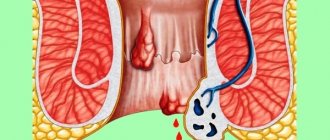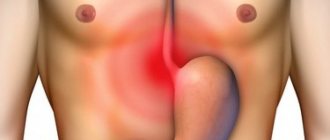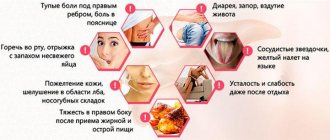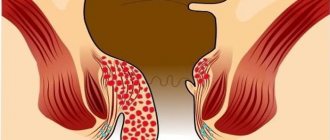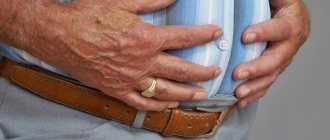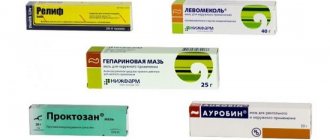Why are hemorrhoids dangerous?
For a woman who has undergone a cesarean section, hemorrhoids will bring a lot of additional inconvenience and aggravate the already serious condition after the operation. The danger of the disease is as follows:
- the development of anemia, it appears in a woman due to large blood loss, the lack of oxygen will negatively affect the lactation process and the composition of milk;
- infection penetrates through damaged nodes, the woman’s body is weakened by bearing a child and undergoing surgery and cannot fully fight microbes;
- a complication of the disease can lead to vein thrombosis.
If the first symptoms of the disease appear, immediate action must be taken. But not all medications can be taken by a woman during breastfeeding, so the treatment process must be approached with full responsibility.
Before starting treatment, you should consult a doctor; a specialist will tell you how to treat the disease and select a special therapy that will be safe for the mother and her baby. It can be treated at home.
Features of therapeutic activities
Treatment is prescribed by a doctor, but the woman herself can help her body fight the disease, which will prevent its possible transition to a more severe and advanced stage.
After cesarean delivery, during bed rest, it is recommended to place a pillow or folded blankets under the lower limbs and pelvis so that the upper body is slightly elevated. Thanks to this, the outflow of blood fluid from the pelvis will significantly improve.
It is important to prevent constipation or fight it if it occurs. For these purposes, the diet is adjusted, and the menu should contain:
- fiber-rich foods;
- fermented milk products;
- porridge;
- fresh fruits and vegetables;
- dried fruits.
Laxatives are used as prescribed by the doctor in clearly indicated dosages. These medications include suppositories with a laxative effect. It is prohibited to independently adjust treatment.
You can also take oral laxatives, but only after a doctor's prior prescription. These drugs include Lactovit and Dufalak. They contain the active component lactulose, which weakens the walls of the intestinal tract, thins and removes feces.
What can you do after surgery?
During the postoperative period, a pregnant woman is on bed rest for several days. In the absence of physical activity and movement, the course of the disease can become complicated due to the formation of stagnation. To prevent this, you need to change your body position. The lower part of the body needs to be raised; for this, a pillow must be placed under the legs and pelvis. Thus, the blood flow will be directed away from the pelvic organs and nodes. This fact will alleviate the condition and eliminate stagnation.
Even while in bed, a woman can perform simple exercises. You can strengthen the sphincter and buttock muscles by periodically squeezing them.
It is very important that a woman not be bothered by constipation. Hard feces can injure the nodes. It is necessary to organize nutrition; it is important that fiber is present in a woman’s diet; it is found in vegetables and cereals.
If constipation does occur, you must take the following medications:
- Duphalac;
- Lactusan;
- Senade.
These products are safe for nursing mothers. Treatment of constipation should be carried out using natural rectal suppositories made on the basis of:
- shark liver;
- propolis;
- mumiyo;
- cacao butter;
- sea buckthorn.
Sometimes you can do enemas with herbs, but often you don't need to resort to them. Otherwise, the intestinal microflora will be disrupted, which in turn will again lead to constipation.
Your doctor will tell you how to treat constipation. He will select the necessary therapeutic complex.
Pain that occurs during an exacerbation can be eliminated with ice. Ice reduces spasms and stops bleeding, freezing the nerve endings, it relieves pain. Ice should be applied to the affected areas for a short time.
After the adaptation period has passed, the woman will need to periodically perform simple physical exercises. It is useful to perform exercises while lying on your back. Such exercises include the well-known “bicycle” and “scissors”.
Prevention of chronic hemorrhoids
With properly selected antihemorrhoidal therapy, the disease disappears completely. To prevent postpartum problems, disease prevention should be carried out before labor.
Preventive measures include:
Proper nutrition
- Balanced diet.
- Use of vitamin and mineral complexes.
- Prevention of constipation, decoctions, herbal teas.
- Active physical activity: yoga, Pilates, exercises.
- When working sedentarily, lifting yourself from the chair every hour to do physical exercises: squats, squeezing/unclamping the anus, walking in place with your knees raised high.
- Enhanced hygiene.
You should wash yourself after each bowel movement; to wipe the anus, you need to use soft hygienic paper. To avoid complications after childbirth, it is necessary to consult a proctologist.
How to treat the disease
Hemorrhoids bring with them various unpleasant sensations; the disease is accompanied by itching, pain and burning in the rectal area. Not all medications are suitable for a nursing woman to treat hemorrhoids after a Caesarean section. It is advisable to choose natural remedies.
Potassium permanganate baths will help relieve pain and burning when symptoms worsen. For such procedures, a light pink solution is prepared, poured into a basin and immersed in it. The session lasts about 15 minutes. After treatment, the anal area should be rinsed with cool water and wiped dry.
The most common remedies for hemorrhoids are suppositories and ointments. For the postpartum period, the safest drugs are chosen. The following products are most popular during lactation:
- Relief;
- Hepatrombin;
- Natalsid;
- Proctosedyl.
Treatment should be carried out under the supervision of a physician and in no case should the dosage be violated. Even natural remedies can cause an allergic reaction, which can develop in both a woman and a child, to whom the allergen will pass along with breast milk. If an allergy occurs, it is necessary to interrupt treatment and replace the medicine with a similar one.
It is better not to take tablets during breastfeeding. If a woman after a Caesarean section had to transfer her child to artificial feeding, then treatment can be carried out in the traditional way without fear for the baby’s health.
Is hemorrhoids an indication for caesarean section?
Hemorrhoids in the first stages of development are not an indication for cesarean section. Only stage 4 of the disease is considered an absolute indication for abdominal surgery. If the pathology began to form during pregnancy and was diagnosed, then timely and adequate therapy can stop hemorrhoidal disease. But even in the absence of diagnosis and treatment, the likelihood of hemorrhoids progressing 9 months to stage 4 is too unlikely.
A gynecologist can visually identify hemorrhoids starting from the second stage. At the same time, the doctor will never ignore the disease. He will refer the patient for a consultation with a proctologist, who will tell you how to behave correctly before childbirth and during childbirth. After this, the patient will be under the constant supervision of two specialists: an obstetrician-gynecologist and a proctologist.
At the beginning of delivery, the condition of the anorectal zone and the stage of hemorrhoids are assessed. Small nodes of stage 1-2 cannot be an obstacle to the passage of the fetus through the natural birth canal, despite the fact that pushing increases intra-abdominal pressure and provokes pain in hemorrhoidal cones. However, the very presence of hemorrhoids complicates the course of labor and increases its duration. But cesarean section is not prescribed, since natural delivery is safe for the baby and helps the woman to quickly rehabilitate.
If hemorrhoids cause severe complications during pregnancy, a cesarean section is mandatory. Natural childbirth in such a situation is dangerous due to uncontrolled heavy bleeding, even death. Rapid contraction of the uterus leads to compression of the nodes, their loss, pinching, necrotization of the node and nearby tissues.
The use of abdominal surgery for hemorrhoids in this case:
- protects internal organs from high labor pressure;
- prevents the negative development of complications;
- eliminates blood stagnation.
Caesarean section for hemorrhoids has its own characteristics: the patient must be examined in advance, the risk of bleeding during childbirth from hemorrhoids must be assessed. During preparation for a cesarean section, a short course of anticoagulants is often prescribed to improve blood clotting. At the same time, a supply of donor blood is being prepared in case an urgent transfusion is needed.
Traditional medicines
Traditional recipes will help relieve the symptoms of the disease. The simplest remedy: potato candles. They are cut from whole potatoes. A potato suppository is inserted into the anus, where it can be left overnight. To lubricate hemorrhoidal cones you can use:
- honey;
- tar;
- propolis;
- onion juice.
This video talks about hemorrhoids after Caesarean:
Baths prepared from a decoction of chamomile or onion peels are made before bed. The duration of this procedure is about 20 minutes. The course of treatment is a week. Using this method, inflammation is relieved and pain is eliminated.
Why do hemorrhoids appear after cesarean section?
Neither vaginal birth nor cesarean section stimulates the spontaneous appearance of hemorrhoids. An exacerbation of this delicate pathology occurs after surgery in those women in labor who suffered from hemorrhoids while pregnant.
This phenomenon occurs everywhere and is caused by the structure of the body and hormonal changes.
- A heavy uterus puts pressure on organs and blood vessels.
- The blood supply to the pelvic area is disrupted.
- Due to high pressure, blood in the veins stagnates.
- The hormone progesterone helps reduce the tone of the vascular walls.
- The intestines stop working adequately, and constipation occurs.
Due to the fact that bed rest is indicated after the operation, stagnation processes provoke the formation of hemorrhoidal cones, and disturbance of the bowel movement leads to their damage and inflammation. Therefore, during rehabilitation after cesarean section, hemorrhoids worsen.
Diet
Constipation complicates the course of the disease. To prevent them from occurring, you need to follow a diet. First of all, you need to stop drinking coffee and strong tea. Confectionery products should be reduced to a minimum. Foods containing complex carbohydrates should be eaten less frequently. It is not recommended to eat a lot:
- pears;
- apples;
- oranges;
- pasta;
- legumes;
- tomatoes;
- zucchini;
- onion.
All of these foods contribute to constipation.
Hemorrhoids must be treated to avoid complications. To combat the disease, you should use drugs based on herbal components, as well as traditional medicine methods.
Forewarned is forearmed
Sometimes during pregnancy, hemorrhoids do not make themselves felt at all and clearly begin to appear only after childbirth. The course of hemorrhoids in women who give birth naturally is no different from its development after a cesarean section. How to recognize the onset of a disease in time in order to minimize the unpleasant and painful consequences of the disease and begin to treat it as early as possible?
If you have varicose veins, then pay special attention to the early diagnosis of hemorrhoids, since you already have a high predisposition to the disease during pregnancy and after childbirth. The first thing you should pay attention to is the appearance of a feeling of heaviness in the anus during bowel movements and other unpleasant sensations that arise for the first time. These are the first signs of the appearance of internal hemorrhoids.
If you do not pay due attention to them and do not contact a specialist to find out the reasons, then discomfort during bowel movements will increase and turn into painful sensations both during and before and after the process of bowel movement. Further, painful sensations will be constantly present, and burning and itching in the anus will be added to them, which causes severe discomfort and fear of defecation.
Itching can be periodic, so the mistake of many women is to believe that they are healthy when it stops. They put off visiting the doctor, thereby triggering the disease. Note that at these stages the disease is easily and quickly treated.
If you continue to ignore these symptoms, you will experience constipation, bleeding, inflammation, prolapse of hemorrhoidal cones and loss of normal functioning and performance due to pain.
What should be the diet for hemorrhoids?
In order for her health to improve and things to get better, a woman must change her eating habits. What diet is recommended for women in labor? A girl after a natural birth and a mother from the 3rd day after a cesarean section need to eat apples, boiled beets, and bread with bran is useful. A special drinking regimen is indicated: a woman in labor should drink about 2 liters. per day.
In order for the intestines to remember its responsibilities, a woman must perform feasible gymnastics: some exercises can be done in bed, walking along the corridor is useful. After discharge, the young mother should remember the diet and formulate a menu taking into account the nutritional characteristics of nursing mothers.
Fresh fruits, a variety of vegetables, cereals and dairy products should be regularly present on the table. Lean meats and fish should also complement the table. For mothers who have recently given birth, certain dietary restrictions have been developed:
- Bakery;
- Chocolate;
- Pickled vegetables;
- Smoked products;
- Spicy dishes.
You can drink water, compote and weak tea. Strong drinks, cocoa and coffee are prohibited. This diet has a beneficial effect on lactation and is an additional measure for the treatment of hemorrhoids.
Treat or endure
Hemorrhoids after childbirth must be treated!
Postpartum hemorrhoids should be treated by a specialist. You can’t think that just relieving pain is enough. Systematic treatment is necessary, since untreated hemorrhoids provoke inflammation of the rectum and bleeding. Even oncology can be a consequence of an advanced disease.
To get rid of this unpleasant illness, patience and diligence are required from a woman: in addition to drug treatment, experts suggest that the patient make lifestyle adjustments.
When to resort to surgery
In cases where drug treatment does not produce the desired effect, hemorrhoids are treated surgically. There is no need to be afraid of surgery: modern clinics actively use low-traumatic techniques that promise quick and painless relief from problems. The following surgical options can be distinguished:
- Sclerotherapy is based on the injection of a sclerosant, a substance that stops blood flow, into the hemorrhoid. The following metamorphoses occur with the fallen ties: they decrease in size and are retracted into the rectum.
- The second option is ligation of the hemorrhoid with latex rings. As a result of such manipulation, the blood supply to the problem area is disrupted and the node is rejected.
- Infrared photocoagulation allows you to cauterize bleeding vessels with a special device - a photocoagulator. The nodes become smaller and press against the intestine.
- After the operation, measures are taken to heal the wound and prevent complications. Chamomile baths are good for helping you recover after surgery. Natalsid suppositories are used, which have wound healing and anti-inflammatory properties. If healing is successful, the patient can return to her previous life.
Symptoms
The disease occurs in two stages. The first stage is chronic. It lasts for a long time, much milder than in the second stage - acute. The main difference is surprise.
Irritation in the anal area, burning sensation are the first manifestations of a disorder in the rectum, felt by a girl after childbirth. Continuous pain is caused by trauma to the mucous membrane, damaged by feces. Over time, after stool, the pain disappears. The feces appear with blood.
The hemorrhoidal node enlarges over time and, due to inflammatory processes, takes on a reddish tint and swelling. The pain felt by the girl in the anal area becomes long-term. Pain increases when walking, in a sitting position with inflammation of the pathology.
With an exacerbation of the disease, complications are recorded - the formation tissues die, cracks appear, and inflammatory processes occur in the tissues located in the rectal area.
The disease progresses slowly, evenly in the chronic stage. There are no obvious signs, the patient has no idea about the disease. Irritation and burning in the anus bother the patient after defecation. Worsened by a feeling of unsatisfactory bowel movements. Painful sensations are not constant and are short-lived. The node bleeds after stool - the blood flow will increase. If there is excessive bleeding after using the toilet, you should consult a doctor so as not to worsen the situation!
During pregnancy, the symptoms of the disease may not bother you. They appear later - after pregnancy, childbirth. It is caused by pressing of vascular formations by the child’s head during childbirth. We are talking about the vessels in the pelvis located in the rectum, which increases pressure. There is a disturbance in the outflow of veins. Enlarged hemorrhoids often fall out after stool. If the nodule falls out, the formations may go back on their own. The phenomenon is recorded when lifting weights. At advanced stages, the nodules cannot be reduced - this is possible with the help of hands. The lumps do not go away - a terrible pathological process of tissue cell death begins to develop, causing massive bleeding hemorrhoids to appear.
Other treatments
Hemorrhoids after childbirth are a common occurrence.
Hirudotherapy is often effective. The leech eliminates venous congestion and the patient begins to feel better. Leech treatment sessions are carried out 21 times a week. 3-4 leeches are used.
The patient should have an idea of how hemorrhoids are treated with leeches. On the day when hirudotherapy is performed, the patient should not smoke or use hygiene products with fragrances.
The anus should be kept clean. Do not forget that hirudotherapy will give the desired effect if the patient does relaxing and tense exercises.
The specialist applies leeches to biologically active points in the area of the sacrum, coccyx, and liver. The procedure is completed when the leeches are saturated. Usually the problem is solved by 10 sessions of treatment with leeches. To stop bleeding, apply a bandage to the bite area, which is fixed with a bandage for a day.
Patients should not worry: the blood circulating in the hemorrhoids does not participate in the general circulation, so anemia and other problems are not scary for a person. The gerudotherapy procedure has contraindications: leeches should not be given to pregnant women and cancer patients.
This auxiliary method should not be used when treating patients with anemia and other blood diseases. Sometimes allergic reactions to leech saliva occur. Women who have given birth and do not have these problems should try the healing capabilities of leeches.

